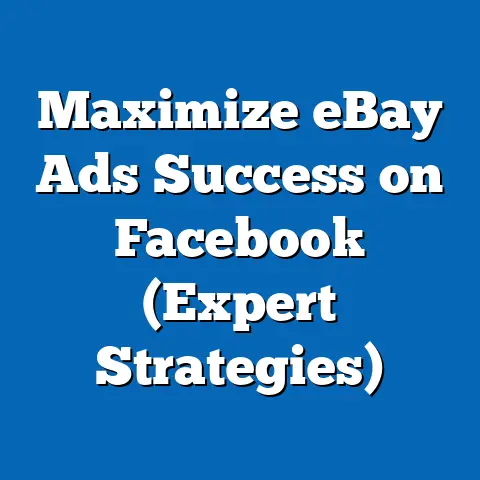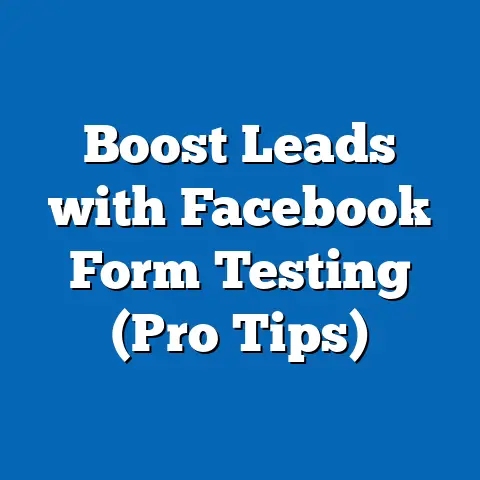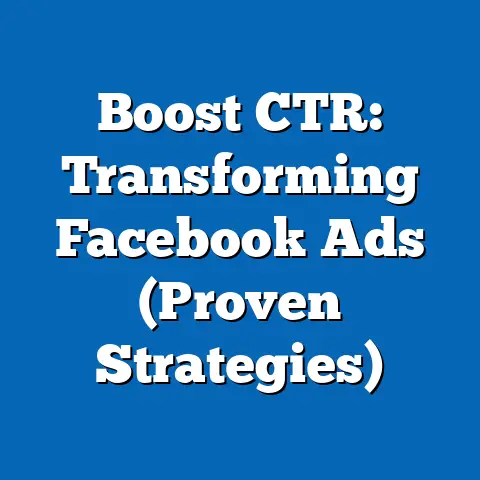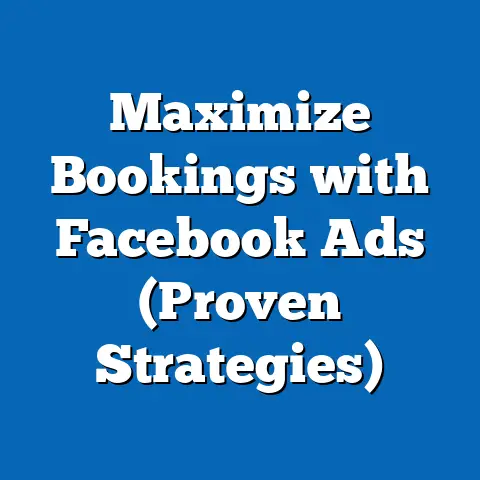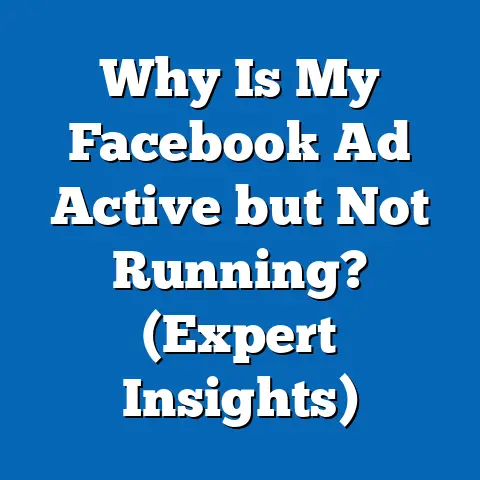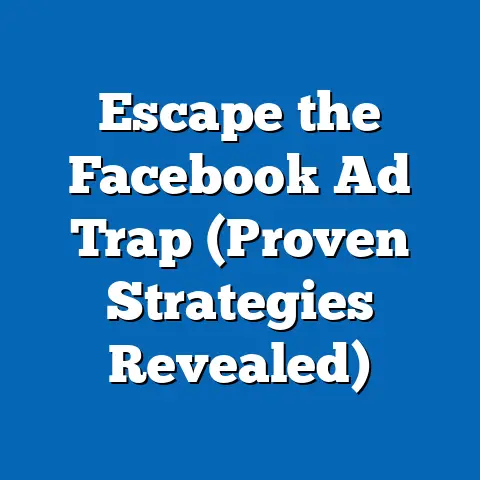Boost Sale Visibility on Facebook (Proven Tactics)
Facebook advertising. The very words can elicit a mix of excitement and dread in business owners and marketers alike. On one hand, it’s a platform brimming with potential – a digital goldmine where you can connect with billions of potential customers. On the other, it can feel like navigating a complex maze, especially when you’re aiming to boost your sale visibility effectively.
I’ve been there, trust me. I remember launching my first Facebook ad campaign for a small, local bakery. I was so excited, I poured my heart into crafting what I thought was the perfect ad. I had mouthwatering photos of their pastries, witty copy, and a call to action that practically begged people to visit. I hit “publish” and waited for the magic to happen.
Crickets.
My initial enthusiasm quickly deflated. What went wrong? I had a great product, a well-designed ad (in my opinion, anyway), and a seemingly targeted audience. But the truth was, I was missing some crucial pieces of the puzzle. I hadn’t truly understood the Facebook advertising landscape, I hadn’t mastered the art of compelling ad content, and I certainly hadn’t grasped the power of granular targeting.
That experience, while initially disheartening, became a pivotal learning moment. It sparked my passion for understanding the intricacies of Facebook advertising and developing strategies that actually work. And that’s what I want to share with you in this article. Forget the complicated jargon and overwhelming technical details. We’re going to focus on proven tactics that you can implement today to boost your sale visibility on Facebook, all while keeping it as straightforward and manageable as possible.
Let’s face it: advertising can be overwhelming, especially on a platform as dynamic as Facebook. That’s why I’m placing a huge emphasis on ease of care when it comes to managing your Facebook ads. The more manageable your campaigns are, the more likely you are to stick with them, optimize them, and ultimately, see the results you’re looking for.
So, buckle up, and let’s dive into the world of Facebook advertising. By the end of this article, you’ll have a clear roadmap for boosting your sale visibility and achieving your business goals on the world’s largest social media platform. Let’s get started!
1: Understanding the Facebook Advertising Landscape
The Facebook advertising landscape has evolved dramatically since its inception. It’s no longer just about throwing up a simple ad and hoping for the best. To truly succeed, you need to understand the platform’s history, its current capabilities, and how to leverage its various ad formats to your advantage.
The Evolution of Facebook Advertising
Facebook advertising began as a relatively simple affair, primarily focused on sidebar ads that were often overlooked. But as the platform grew and its user base exploded, Facebook recognized the potential to offer businesses more sophisticated advertising options.
Over the years, Facebook has continuously refined its algorithms, improved its targeting capabilities, and introduced new ad formats. This evolution has been driven by several factors:
- Increased competition: As more businesses flocked to Facebook, the competition for ad space intensified. This forced Facebook to develop more effective ways for advertisers to reach their target audiences.
- Changing user behavior: User behavior on Facebook has changed significantly over time. People are now more likely to consume content on mobile devices, and they’re more discerning about the ads they see.
- Technological advancements: Advancements in artificial intelligence (AI) and machine learning have enabled Facebook to offer more personalized and relevant ad experiences.
Today, Facebook advertising is a complex ecosystem with a wide range of tools and features. It’s a far cry from the simple sidebar ads of the past. But this complexity also presents a huge opportunity for businesses that are willing to invest the time and effort to understand the platform.
I remember when Facebook first introduced its Power Editor (now Ads Manager). It felt incredibly daunting at the time! There were so many options and settings that it was easy to get lost. But as I started experimenting and learning, I realized the power it gave me to fine-tune my campaigns and target my audience with laser precision.
Exploring Facebook Ad Formats
One of the most important aspects of understanding the Facebook advertising landscape is familiarizing yourself with the different ad formats available. Each format has its own strengths and weaknesses, and the best format for your business will depend on your specific goals and target audience.
Here’s a rundown of some of the most popular Facebook ad formats:
- Image Ads: These are the simplest and most common type of Facebook ad. They consist of a single image, ad copy, and a call to action. Image ads are great for showcasing products, promoting events, or building brand awareness.
- Video Ads: Video ads are becoming increasingly popular, as they’re highly engaging and can effectively capture attention. They can be used to tell stories, demonstrate products, or share testimonials.
- Carousel Ads: Carousel ads allow you to showcase multiple images or videos in a single ad unit. This format is ideal for highlighting different features of a product, showcasing a product line, or telling a story in a sequential manner.
- Collection Ads: Collection ads are designed for e-commerce businesses. They feature a hero image or video at the top, followed by a grid of product images below. When a user clicks on a product image, they’re taken directly to the product page on your website.
- Instant Experience Ads (formerly Canvas Ads): Instant Experience ads are full-screen, mobile-optimized ads that load instantly when a user clicks on them. They can include a variety of elements, such as images, videos, carousels, and text.
- Lead Ads: Lead ads are designed to collect leads directly within Facebook. They feature a pre-filled form that users can submit with just a few taps. This format is ideal for generating leads for sales teams or building an email list.
Choosing the right ad format is crucial for driving sales. For example, if you’re selling a complex product, a video ad might be the best way to demonstrate its features and benefits. On the other hand, if you’re running a limited-time promotion, an image ad with a clear call to action might be more effective.
The Power of Audience Segmentation and Targeting
Facebook’s targeting capabilities are what truly set it apart from other advertising platforms. The platform collects a vast amount of data about its users, including their demographics, interests, behaviors, and connections. This data allows you to target your ads with incredible precision.
Here are some of the key targeting options available on Facebook:
- Demographic Targeting: This allows you to target users based on their age, gender, location, education, job title, and other demographic information.
- Interest Targeting: This allows you to target users based on their interests, hobbies, and passions. Facebook infers these interests based on the pages users like, the groups they join, and the content they interact with.
- Behavior Targeting: This allows you to target users based on their online behavior, such as their purchase history, their device usage, and their travel habits.
- Custom Audiences: Custom audiences allow you to target users who have already interacted with your business, such as your website visitors, your email subscribers, or your customers.
- Lookalike Audiences: Lookalike audiences allow you to target users who are similar to your existing customers. Facebook analyzes the characteristics of your custom audience and finds other users who share those same characteristics.
To effectively leverage Facebook’s targeting capabilities, you need to understand your ideal customer. Who are they? What are their interests? What are their pain points? Once you have a clear understanding of your target audience, you can use Facebook’s targeting options to reach them with relevant and engaging ads.
Takeaway: The Facebook advertising landscape is constantly evolving. To stay ahead of the curve, it’s important to understand the platform’s history, its various ad formats, and its powerful targeting capabilities. By mastering these elements, you can create effective Facebook ad campaigns that drive real results.
Next Steps: Spend some time exploring the different ad formats and targeting options available on Facebook. Use Facebook’s Audience Insights tool to learn more about your target audience and identify the best ways to reach them.
2: Crafting Compelling Ad Content
Even with the best targeting in the world, your Facebook ads will fall flat if your content isn’t compelling. Think about it: people are bombarded with ads every day. To stand out from the crowd, you need to grab their attention and give them a reason to click. That’s where the art of crafting compelling ad content comes in.
The Elements of Effective Ad Copywriting
Ad copywriting is more than just writing a catchy headline. It’s about understanding your target audience, crafting a message that resonates with them, and driving them to take action. Here are some key techniques for writing effective ad copy:
- Know Your Audience: Before you start writing, take the time to understand your target audience. What are their needs, wants, and pain points? What kind of language do they use? The more you know about your audience, the better you’ll be able to craft a message that resonates with them.
- Write Engaging Headlines: Your headline is the first thing people will see, so it needs to be attention-grabbing. Use strong verbs, intriguing questions, or compelling offers to entice people to click.
- Persuasive Descriptions: Your description should expand on your headline and provide more information about your product or service. Highlight the benefits, not just the features. Explain how your product or service can solve your audience’s problems or improve their lives.
- Clear Calls to Action (CTAs): Your call to action tells people what you want them to do next. Use clear and concise language, such as “Shop Now,” “Learn More,” or “Get Started.” Make sure your CTA is visually prominent and easy to click.
- Keep it Concise: People have short attention spans, so it’s important to keep your ad copy concise and to the point. Get rid of any unnecessary words or phrases.
- Use a Conversational Tone: Write like you’re talking to a friend. Avoid using jargon or overly technical language.
- Test Different Versions: Don’t be afraid to experiment with different versions of your ad copy. A/B testing can help you identify the most effective headlines, descriptions, and CTAs.
I’ve learned that sometimes the simplest ad copy is the most effective. I once ran an ad for a local coffee shop that simply said, “Need a caffeine fix? Stop by [Coffee Shop Name] and try our delicious lattes!” It was short, sweet, and to the point, and it generated a surprisingly high click-through rate.
Analyzing High-Performing Ad Content
To get a better understanding of what works, let’s analyze some examples of high-performing ad content:
-
Example 1: Shopify
- Headline: Start Your Online Store Today
- Description: Shopify is the leading e-commerce platform for businesses of all sizes. Get a free trial and start selling online today!
- CTA: Start Free Trial
- Why it works: This ad is clear, concise, and benefits-driven. It highlights the fact that Shopify is the leading e-commerce platform and offers a free trial to entice people to sign up.
-
Example 2: Grammarly
-
Headline: Improve Your Writing with Grammarly
- Description: Grammarly is a powerful writing assistant that helps you write clear, concise, and error-free content. Try it for free today!
- CTA: Get Grammarly
- Why it works: This ad addresses a common pain point (poor writing) and offers a solution (Grammarly). It also highlights the fact that Grammarly is free to try, which makes it less risky for potential users.
-
Example 3: MasterClass
-
Headline: Learn from the Best with MasterClass
- Description: MasterClass offers online classes taught by world-renowned experts. Learn cooking from Gordon Ramsay, writing from Margaret Atwood, and more!
- CTA: Explore MasterClass
- Why it works: This ad leverages the power of celebrity endorsements. It highlights the fact that MasterClass offers classes taught by famous people, which makes it more appealing to potential students.
Example 1: Shopify
- Headline: Start Your Online Store Today
- Description: Shopify is the leading e-commerce platform for businesses of all sizes. Get a free trial and start selling online today!
- CTA: Start Free Trial
- Why it works: This ad is clear, concise, and benefits-driven. It highlights the fact that Shopify is the leading e-commerce platform and offers a free trial to entice people to sign up.
-
Example 2: Grammarly
-
Headline: Improve Your Writing with Grammarly
- Description: Grammarly is a powerful writing assistant that helps you write clear, concise, and error-free content. Try it for free today!
- CTA: Get Grammarly
- Why it works: This ad addresses a common pain point (poor writing) and offers a solution (Grammarly). It also highlights the fact that Grammarly is free to try, which makes it less risky for potential users.
-
Example 3: MasterClass
-
Headline: Learn from the Best with MasterClass
- Description: MasterClass offers online classes taught by world-renowned experts. Learn cooking from Gordon Ramsay, writing from Margaret Atwood, and more!
- CTA: Explore MasterClass
- Why it works: This ad leverages the power of celebrity endorsements. It highlights the fact that MasterClass offers classes taught by famous people, which makes it more appealing to potential students.
Example 2: Grammarly
Headline: Improve Your Writing with Grammarly
Example 3: MasterClass
Headline: Learn from the Best with MasterClass
These examples demonstrate that effective ad content is clear, concise, benefits-driven, and includes a strong call to action.
The Significance of Visual Elements
While compelling ad copy is essential, the visual elements of your ads are just as important. In fact, studies have shown that visuals are processed 60,000 times faster than text. This means that your images and videos have a huge impact on user engagement and conversion rates.
Here are some tips for selecting effective visual elements for your ads:
- Use High-Quality Images and Videos: Your visuals should be clear, crisp, and visually appealing. Avoid using blurry or pixelated images.
- Choose Relevant Visuals: Your visuals should be relevant to your product or service. If you’re selling clothing, show people wearing your clothes. If you’re selling food, show mouthwatering photos of your dishes.
- Use Eye-Catching Colors: Use colors that will grab people’s attention and make your ads stand out from the crowd.
- Show People: Images and videos that feature people tend to perform better than those that don’t. This is because people are naturally drawn to faces.
- Test Different Visuals: Just like with ad copy, it’s important to test different visuals to see what works best.
I once worked with a real estate agent who was struggling to generate leads on Facebook. We tried a variety of different ad creatives, but nothing seemed to work. Then, we decided to try a video tour of a beautiful home that he was selling. The video was professionally produced and showcased the home’s best features. The results were amazing! The video ad generated a huge number of leads, and the agent was able to sell the home quickly.
Takeaway: Compelling ad content is a combination of effective copywriting and visually appealing elements. By understanding your audience, crafting a message that resonates with them, and using high-quality visuals, you can create Facebook ads that grab attention and drive results.
Next Steps: Review your existing Facebook ads and identify areas where you can improve your ad copy and visuals. Experiment with different headlines, descriptions, CTAs, and images to see what works best.
3: Utilizing Facebook Ad Targeting Features
We’ve touched on the importance of targeting, but let’s dive deeper into the specifics. Facebook’s ad targeting features are incredibly powerful, allowing you to reach the right people with the right message at the right time. Mastering these features is crucial for maximizing your ROI and boosting your sale visibility.
Exploring Facebook’s Targeting Options
Facebook offers a wide range of targeting options, allowing you to reach your ideal customer based on a variety of factors. Here’s a more detailed look at some of the key options:
- Demographic Targeting: As mentioned earlier, this allows you to target users based on their age, gender, location, education, job title, and other demographic information. This is a good starting point for most campaigns, but it’s important to go beyond demographics and consider other factors as well. For example, you might want to target women aged 25-44 who live in a specific city and have a college degree.
- Interest Targeting: This allows you to target users based on their interests, hobbies, and passions. Facebook infers these interests based on the pages users like, the groups they join, and the content they interact with. This is a great way to reach people who are passionate about a particular topic or activity. For example, you might want to target people who are interested in cooking, travel, or fashion.
- Behavior Targeting: This allows you to target users based on their online behavior, such as their purchase history, their device usage, and their travel habits. This is a powerful way to reach people who are likely to be interested in your product or service. For example, you might want to target people who have recently purchased a similar product, or people who have visited your website in the past.
- Connections Targeting: This allows you to target users based on their connections to your Facebook page or app. This is a great way to reach people who are already familiar with your brand. For example, you might want to target people who like your Facebook page, or people who have installed your app.
Creating Lookalike Audiences
Lookalike audiences are one of Facebook’s most powerful targeting features. They allow you to target users who are similar to your existing customers, based on a variety of factors.
To create a lookalike audience, you first need to create a custom audience. This can be based on your website visitors, your email subscribers, your customers, or any other group of people who have interacted with your business.
Once you’ve created your custom audience, you can then create a lookalike audience based on that audience. Facebook will analyze the characteristics of your custom audience and find other users who share those same characteristics.
Lookalike audiences are a great way to expand your reach and find new customers who are likely to be interested in your product or service.
I’ve seen lookalike audiences work wonders for businesses in a variety of industries. I once worked with an online clothing retailer who was struggling to generate sales. We created a lookalike audience based on their existing customers, and the results were incredible. The lookalike audience generated a significantly higher conversion rate than any of their other targeting options.
Retargeting Campaigns: Re-Engaging Potential Customers
Retargeting campaigns allow you to re-engage potential customers who have already interacted with your brand. This is a highly effective way to boost your sale visibility and drive conversions.
There are several ways to retarget potential customers on Facebook:
- Website Retargeting: This allows you to target users who have visited your website in the past. You can target all website visitors, or you can target specific pages or sections of your website.
- Engagement Retargeting: This allows you to target users who have interacted with your Facebook page or app. You can target people who have liked your page, commented on your posts, or watched your videos.
- Lead Ad Retargeting: This allows you to target users who have submitted a lead form on Facebook.
Retargeting campaigns are particularly effective because you’re targeting people who are already familiar with your brand and have shown some interest in your product or service.
Takeaway: Facebook’s targeting features are incredibly powerful, allowing you to reach the right people with the right message at the right time. By mastering these features, you can maximize your ROI and boost your sale visibility.
Next Steps: Experiment with different targeting options to see what works best for your business. Create a lookalike audience based on your existing customers, and set up retargeting campaigns to re-engage potential customers who have already interacted with your brand.
4: Budgeting and Bidding Strategies
Understanding how to effectively budget and bid on Facebook ads is crucial for maximizing your ROI. You don’t want to overspend and waste money, but you also don’t want to underspend and miss out on potential customers. Finding the right balance is key.
Setting a Budget for Facebook Ads
Setting a budget for your Facebook ads is the first step in managing your ad spend. There are two main types of budgets you can set on Facebook:
- Daily Budget: This is the average amount you’re willing to spend each day on your ads. Facebook will try to spend your daily budget each day, but it may spend slightly more or less on some days.
- Lifetime Budget: This is the total amount you’re willing to spend on your ads over the entire duration of the campaign. Facebook will try to spread your budget evenly over the campaign period, but it may spend more or less on some days.
When setting your budget, it’s important to consider your business goals, your target audience, and your budget constraints. How much are you willing to spend to acquire a new customer? How much revenue do you expect to generate from each customer?
It’s also important to remember that your budget is not set in stone. You can adjust your budget at any time, based on your ad performance. If your ads are performing well, you might want to increase your budget to reach more people. If your ads are underperforming, you might want to decrease your budget or pause your campaign altogether.
I always recommend starting with a smaller budget and gradually increasing it as you see results. This allows you to test different targeting options, ad creatives, and bidding strategies without risking a large amount of money.
Understanding Bidding Strategies
Facebook offers a variety of bidding strategies, each designed to help you achieve different goals. Here are some of the most common bidding strategies:
- Highest Volume: This bidding strategy is designed to get you the most results for your budget. Facebook will automatically bid on your behalf, trying to get you the lowest cost per result. This is a good option if you’re primarily focused on driving traffic or generating leads.
- Cost Per Result Goal: This bidding strategy allows you to set a target cost per result. Facebook will then try to get you results at or below your target cost. This is a good option if you have a specific cost per acquisition (CPA) goal in mind.
- Value Optimization: This bidding strategy is designed to maximize the value of your conversions. Facebook will try to show your ads to people who are most likely to make a purchase and spend the most money. This is a good option if you’re primarily focused on driving sales.
- Manual Bidding: This bidding strategy allows you to manually set your bids for each ad set. This gives you more control over your bidding, but it also requires more time and effort.
The best bidding strategy for your campaign will depend on your specific goals and objectives. If you’re not sure which bidding strategy to choose, I recommend starting with the “Highest Volume” strategy and then experimenting with other strategies as you gather more data.
Optimizing Ad Spend for Maximum ROI
Optimizing your ad spend is an ongoing process. It requires constantly monitoring your ad performance, analyzing your data, and making adjustments to your campaigns.
Here are some tips for optimizing your ad spend:
- Track Your Key Metrics: Keep track of your key metrics, such as click-through rate (CTR), conversion rate, cost per acquisition (CPA), and return on ad spend (ROAS). This will help you identify which ads are performing well and which ads are not.
- A/B Test Your Ads: A/B testing allows you to test different versions of your ads to see which ones perform best. You can test different headlines, descriptions, images, and CTAs.
- Refine Your Targeting: Regularly review your targeting options to make sure you’re reaching the right people. Experiment with different targeting options to see which ones generate the best results.
- Pause Underperforming Ads: If an ad is not performing well, don’t be afraid to pause it. There’s no point in wasting money on ads that aren’t generating results.
- Adjust Your Budget: If your ads are performing well, consider increasing your budget to reach more people. If your ads are underperforming, consider decreasing your budget or pausing your campaign altogether.
Takeaway: Setting a budget and choosing the right bidding strategy are essential for maximizing your ROI on Facebook ads. By constantly monitoring your ad performance, analyzing your data, and making adjustments to your campaigns, you can optimize your ad spend and drive more sales.
Next Steps: Review your current Facebook ad campaigns and make sure you have a clear budget in place. Experiment with different bidding strategies to see which ones work best for your business. Regularly monitor your ad performance and make adjustments to your campaigns as needed.
5: Analyzing and Optimizing Ad Performance
Running Facebook ads isn’t a “set it and forget it” endeavor. It requires constant monitoring, analysis, and optimization to ensure you’re getting the best possible results. Understanding your key performance indicators (KPIs) and how to interpret them is essential for making informed decisions about your campaigns.
Tracking and Analyzing Ad Performance Metrics
Facebook Ads Manager provides a wealth of data about your ad performance. Here are some of the most important metrics to track:
- Impressions: The number of times your ad was shown to people. This metric gives you an idea of your ad’s reach.
- Reach: The number of unique people who saw your ad. This metric is different from impressions because it only counts each person once, even if they saw your ad multiple times.
- Click-Through Rate (CTR): The percentage of people who saw your ad and clicked on it. This metric indicates how engaging your ad is. A higher CTR suggests that your ad copy and visuals are resonating with your target audience.
- Conversion Rate: The percentage of people who clicked on your ad and then completed a desired action, such as making a purchase, filling out a form, or signing up for a newsletter. This metric measures the effectiveness of your landing page and your overall sales funnel.
- Cost Per Click (CPC): The average amount you paid for each click on your ad. This metric helps you understand the cost-effectiveness of your ads.
- Cost Per Acquisition (CPA): The average amount you paid to acquire a new customer. This metric is crucial for understanding your ROI.
- Return on Ad Spend (ROAS): The amount of revenue you generated for every dollar you spent on advertising. This metric is the ultimate measure of your ad campaign’s success.
It’s important to track these metrics over time so you can identify trends and patterns. Are your CTRs improving or declining? Is your CPA increasing or decreasing? By monitoring your metrics, you can identify areas where you need to make adjustments to your campaigns.
I remember working with a client who was running Facebook ads to promote a new product. Their CTR was relatively high, but their conversion rate was very low. After digging deeper, we discovered that their landing page was poorly designed and didn’t clearly explain the benefits of the product. We redesigned the landing page, and their conversion rate skyrocketed.
Tools for Monitoring Performance in Facebook Ads Manager
Facebook Ads Manager provides a variety of tools for monitoring your ad performance. Here are some of the most useful tools:
- Dashboards: Ads Manager allows you to create custom dashboards that display the metrics that are most important to you. This makes it easy to quickly see how your campaigns are performing.
- Reports: Ads Manager allows you to generate detailed reports that provide insights into your ad performance. You can filter your reports by date range, ad set, and other criteria.
- Breakdowns: Ads Manager allows you to break down your ad performance by demographic, placement, and other factors. This can help you identify which segments of your audience are most responsive to your ads.
- Attribution: Facebook Attribution helps you understand how different marketing touchpoints contribute to your conversions. This can help you optimize your campaigns for maximum ROI.
Actionable Insights for Optimizing Underperforming Ads
If you notice that some of your ads are underperforming, don’t panic! There are several things you can do to optimize them:
- Improve Your Ad Copy: Try rewriting your headlines, descriptions, and CTAs to make them more engaging and persuasive.
- Update Your Visuals: Experiment with different images and videos to see which ones resonate best with your target audience.
- Refine Your Targeting: Make sure you’re targeting the right people with your ads. Experiment with different demographic, interest, and behavior targeting options.
- Optimize Your Landing Page: Make sure your landing page is clear, concise, and easy to navigate. Highlight the benefits of your product or service, and make it easy for people to convert.
- Adjust Your Bidding Strategy: Experiment with different bidding strategies to see which one generates the best results for your budget.
Takeaway: Analyzing and optimizing your ad performance is an ongoing process. By tracking your key metrics, using the tools available in Facebook Ads Manager, and taking action to improve underperforming ads, you can maximize your ROI and drive more sales.
Next Steps: Set up custom dashboards in Facebook Ads Manager to track your key metrics. Regularly review your ad performance and identify areas where you can make improvements. Don’t be afraid to experiment with different ad creatives, targeting options, and bidding strategies.
6: Leveraging Facebook Insights and A/B Testing
Facebook Insights and A/B testing are two powerful tools that can help you understand your audience better and optimize your ad campaigns for maximum effectiveness. They’re like having a direct line to your customers’ minds, allowing you to see what resonates with them and what doesn’t.
The Role of Facebook Insights
Facebook Insights provides valuable data about your audience and their behavior on Facebook. This data can help you understand their demographics, interests, and preferences, which can inform your ad targeting and creative decisions.
Here are some of the key insights you can glean from Facebook Insights:
- Demographics: Understand the age, gender, location, education level, and relationship status of your audience. This can help you refine your targeting to reach the most relevant people.
- Interests: Discover the topics and interests that your audience cares about. This can help you create more engaging ad copy and visuals that resonate with their passions.
- Behavior: Learn about the actions your audience takes on Facebook, such as the pages they like, the groups they join, and the events they attend. This can help you understand their online behavior and identify potential customers.
- Page Performance: Track the performance of your Facebook page, including the number of likes, comments, shares, and clicks. This can help you understand what content is resonating with your audience and what content is not.
- Post Performance: Analyze the performance of individual posts on your Facebook page, including the reach, engagement, and click-through rate. This can help you identify the most effective types of content to share.
By regularly reviewing Facebook Insights, you can gain a deeper understanding of your audience and their behavior on Facebook. This can help you make more informed decisions about your ad targeting, creative, and content strategy.
The Importance of A/B Testing
A/B testing, also known as split testing, is a process of comparing two versions of an ad to see which one performs better. This is a powerful way to optimize your ad campaigns and improve your ROI.
You can A/B test a variety of different elements of your ads, including:
- Headlines: Test different headlines to see which one generates the most clicks.
- Descriptions: Test different descriptions to see which one is more persuasive.
- Images: Test different images to see which one is more visually appealing.
- CTAs: Test different calls to action to see which one drives the most conversions.
- Targeting: Test different targeting options to see which ones reach the most relevant audience.
The key to successful A/B testing is to only test one element at a time. This allows you to isolate the impact of each element and determine which one is driving the results.
Setting Up A/B Tests: A Step-by-Step Guide
Here’s a step-by-step guide on how to set up A/B tests in Facebook Ads Manager:
- Create a New Campaign: Start by creating a new campaign in Ads Manager.
- Choose Your Objective: Select your campaign objective, such as traffic, conversions, or lead generation.
- Create an Ad Set: Create an ad set and define your target audience, budget, and schedule.
- Create Two Ads: Create two different versions of your ad, changing only one element at a time. For example, you might create two ads with different headlines but the same description and image.
- Run Your Test: Run your test for a sufficient amount of time to gather enough data. Facebook recommends running your test for at least four days.
- Analyze Your Results: After your test has run, analyze the results to see which ad performed better. Look at metrics such as CTR, conversion rate, and CPA.
- Implement Your Findings: Based on your results, implement the winning ad into your campaign. You can then continue to A/B test other elements of your ads to further optimize your performance.
Takeaway: Facebook Insights and A/B testing are two powerful tools that can help you understand your audience better and optimize your ad campaigns for maximum effectiveness. By regularly reviewing Facebook Insights and conducting A/B tests, you can continuously improve your ad performance and drive more sales.
Next Steps: Start exploring Facebook Insights to learn more about your audience and their behavior on Facebook. Set up your first A/B test to compare two different versions of your ads and see which one performs better.
Conclusion
Boosting your sale visibility on Facebook is an ongoing journey that requires a combination of strategic planning, creative execution, and continuous optimization. By understanding the Facebook advertising landscape, crafting compelling ad content, utilizing Facebook’s targeting features, optimizing your budget and bidding strategies, analyzing your ad performance, and leveraging Facebook Insights and A/B testing, you can create effective Facebook ad campaigns that drive real results.
Remember, the key to success is to stay informed, stay adaptable, and always be willing to experiment. The Facebook advertising landscape is constantly evolving, so it’s important to stay up-to-date on the latest trends and best practices.
And don’t forget the importance of ease of care. The more manageable your campaigns are, the more likely you are to stick with them, optimize them, and ultimately, achieve your business goals on Facebook.
So, go forth, implement these proven tactics, and monitor your results. With the right strategies and a focus on continuous improvement, you can unlock the full potential of Facebook advertising and boost your sale visibility to new heights. Good luck!

